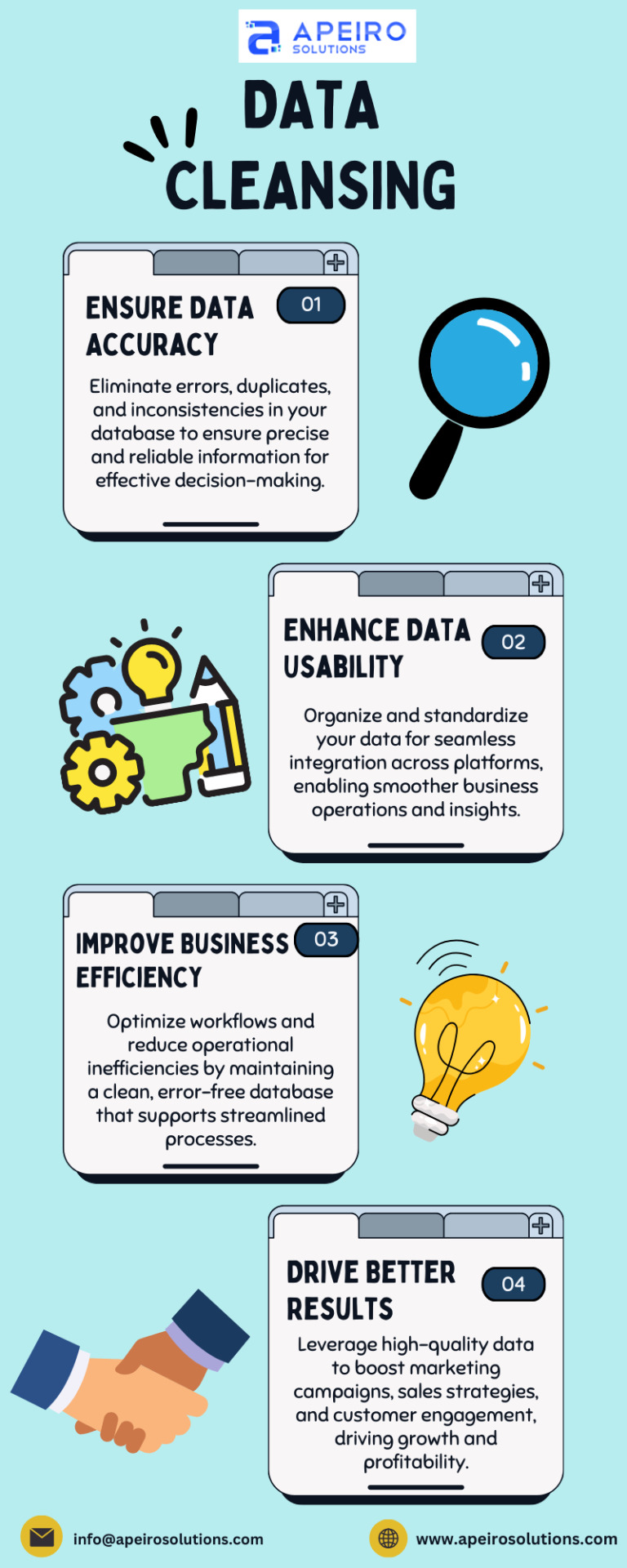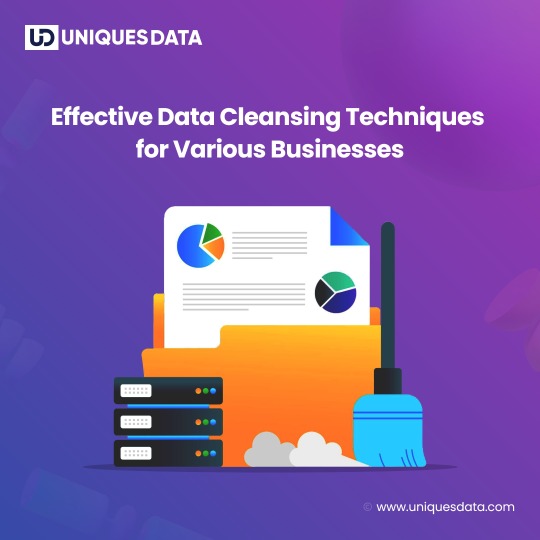#data cleansing service
Explore tagged Tumblr posts
Text
Elevate Business ROI with Data Cleansing Services

Businesses manage a large amount of data on a daily basis, and it is important to ensure the database is clean and accurate for further use. Data cleansing can improve the quality of data and bring valuable insights. Check out in detail how data cleansing plays an important role.
#data cleansing services#database cleansing services#data enrichment services#data cleansing company#outsource data cleansing#data cleansing service#data cleansing companies#outsource data cleansing services#outsource data enrichment#data cleansing outsourcing
3 notes
·
View notes
Text
Unlock the full potential of your business data with our data cleansing services. Ensure accuracy, consistency, and reliability by eliminating errors and inconsistencies. Our team of experts specializes in data cleaning and formatting, providing tailored solutions to meet your unique needs. Enhance decision-making and drive business growth with clean, actionable data. Trust our professional services to maintain the integrity and quality of your information.
#data formatting services#data cleansing#data cleansing service#data cleansing services#outsource data cleansing services
0 notes
Text
Outsourced b2b lead generation

Lead generation refers to a procedure to find, nurture, contact and convert leads into your potential buyers. Due to its complexity and criticalness, outsourcing to an experienced lead generation organisation can be helpful. With this outsourced B2b lead generation, your sales and efficiency can be developed in the sales procedure.
3 notes
·
View notes
Text
If I had 8 hours to build a machine learning model, I’d spend the first 6 hours preparing my dataset.
- Abraham Lossfunction
#datascience#dataanalytics#coding#machinelearning#programming#python#programmer#artificialintelligence#deeplearning#data cleansing services
2 notes
·
View notes
Text
AI Costs Are Accelerating — Here’s How to Keep Them Under Control
New Post has been published on https://thedigitalinsider.com/ai-costs-are-accelerating-heres-how-to-keep-them-under-control/
AI Costs Are Accelerating — Here’s How to Keep Them Under Control


Cloud usage continues to soar, as do its associated costs — particularly, of late, those driven by AI. Gartner analysts predict worldwide end-user spending on public cloud services will swell to $723.4 billion in 2025, up from just under $600 billion in 2024. And 70% of executives surveyed in an IBM report cited generative AI as a critical driver of this increase.
At the same time, China’s DeepSeek made waves when it claimed it took just two months and $6 million to train its AI model. There’s some doubt whether those figures tell the whole story, but if Microsoft and Nvidia’s still-jolted share prices are any indication, the announcement woke the Western world up to the need for cost-efficient AI systems.
To date, companies have been able to treat mounting AI costs as R&D write-offs. But AI costs — especially those associated with successful products and features — will eventually hit companies’ cost of goods sold (COGS) and, consequently, their gross margins. AI innovations were always destined to face the cold scrutiny of business sense; DeepSeek’s bombshell announcement just shortened that timeline.
Just like they do with the rest of the public cloud, companies will need to manage their AI costs, including both training and consumption costs. They’ll need to connect AI spending with business outcomes, optimize AI infrastructure costs, refine pricing and packaging strategies, and maximize the return on their AI investments.
How can they do it? With cloud unit economics (CUE).
What is cloud unit economics (CUE)?
CUE comprises the measurement and maximization of cloud-driven profit. Its fundamental mechanism is connecting cloud cost data with customer demand and revenue data, revealing the most and least profitable dimensions of a business and thus showing companies how and where to optimize. CUE applies across all sources of cloud spending, including AI costs.
The foundation of CUE is cost allocation — organizing cloud costs according to who and/or what drives them. Common allocation dimensions include cost per customer, cost per engineering team, cost per product, cost per feature, and cost per microservice. Companies using a modern cost management platform often allocate costs in a framework that mirrors their business structure (their engineering hierarchy, platform infrastructure, etc.).
Then, the heart of CUE is the unit cost metric, which compares cost data with demand data to show a company their all-in cost to serve. For example, a B2B marketing company might want to calculate its “cost per 1,000 messages” sent via its platform. To do this, it would have to track its cloud costs and the number of messages sent, feed that data into a single system, and instruct that system to divide its cloud costs by its messages and graph the result in a dashboard.
Since the company started with cost allocation, it could then view its cost per 1,000 messages by customer, product, feature, team, microservice, or whatever other view it deemed reflective of its business structure.
The results:
Flexible business dimensions by which they can filter their unit cost metric, showing them which areas of their business are driving their cloud costs
An illuminating unit cost metric that shows them how efficiently they’re meeting customer demand
The ability to make targeted efficiency improvements, like refactoring infrastructure, tweaking customer contracts, or refining pricing and packaging models
CUE in the AI age
In the CUE model, AI costs are just one more source of cloud spending that can be incorporated into a business’s allocation framework. The way that AI companies disseminate cost data is still evolving, but in principle, cost management platforms treat AI costs in much the same way as they treat AWS, Azure, GCP, and SaaS costs.
Modern cloud cost management platforms allocate AI costs and show their efficiency impact in the context of unit cost metrics.
Companies should allocate their AI costs in a handful of intuitive ways. One would be the aforementioned cost per team, an allocation dimension common to all sources of cloud spending, showing the costs that each engineering team is responsible for. This is particularly useful because leaders know exactly who to notify and hold accountable when a particular team’s costs spike.
Companies might also want to know their cost per AI service type — machine learning (ML) models versus foundation models versus third-party models like OpenAI. Or, they could calculate their cost per SDLC stage to understand how an AI-powered feature’s costs change as it transitions from development to testing to staging and finally to production. A company could get even more granular and calculate its cost per AI development lifecycle stage, including data cleansing, storage, model creation, model training, and inference.
Zooming out from the weeds a bit: CUE means comparing organized cloud cost data with customer demand data and then figuring out where to optimize. AI costs are just one more source of cloud cost data that, with the right platform, fit seamlessly into a company’s overall CUE strategy.
Avoiding the COGS tsunami
As of 2024, only 61% of companies had formalized cloud cost management systems in place (per a CloudZero survey). Unmanaged cloud costs soon become unmanageable: 31% of companies — similar to the portion who don’t formally manage their costs — suffer major COGS hits, reporting that cloud costs consume 11% or more of their revenue. Unmanaged AI costs will only exacerbate this trend.
Today’s most forward-thinking organizations treat cloud costs like any other major expenditure, calculating its ROI, breaking that ROI down by their most critical business dimensions, and empowering the relevant team members with the data needed to optimize that ROI. Next-generation cloud cost management platforms offer a comprehensive CUE workflow, helping companies avoid the COGS tsunami and bolster long-term viability.
#000#2024#2025#ai#AI costs#AI development#AI Infrastructure#ai model#AI systems#AI-powered#amp#AWS#azure#B2B#billion#Business#change#China#Cloud#cloud services#cloud spending#CloudZero#Companies#comprehensive#Cost-efficient AI#dashboard#data#data cleansing#deepseek#development
0 notes
Text
Ensuring accurate and up-to-date CRM data is crucial for business success. aMarket Force specializes in CRM Data Cleansing Services, helping businesses eliminate duplicate, outdated, and incorrect data. With expertise in data accuracy, customized solutions, and cutting-edge tools, they ensure your CRM system remains a valuable asset for customer engagement and decision-making. Their services improve efficiency, enhance marketing campaigns, and ensure regulatory compliance.
Whether switching CRM systems or optimizing existing databases, aMarket Force provides scalable and reliable solutions. Contact them today for a free CRM database cleaning consultation and transform your data into a competitive advantage!
0 notes
Text
Data Cleaning Services is inevitable for growth

Data cleaning or scrubbing is an important process in various businesses that corrects and enhances data value by removing duplicate, irrelevant, and missed-value content. Outsource data cleaning services to have an accurate database. Continue to read further in detail.
#data cleansing services#data cleaning services#database cleansing services#data enrichment services#data cleansing company#outsource data cleansing
1 note
·
View note
Text
Product Data Cleansing for Ecommerce Business Success

E-commerce is rapidly growing in the global economy, and this demands an accurate dataset. Data cleansing services play a key role in online business success, helping to streamline operational activities.
#data cleansing services#database cleansing services#data enrichment services#data cleansing company#outsource data cleansing#data cleansing service#data cleansing companies#outsource data cleansing services#outsource data enrichment#data cleansing outsourcing
1 note
·
View note
Text

Check out this infographic on ‘Strategies for Improving Data Quality Through Data Cleansing Services.’
In today's data-driven world, ensuring high-quality data is essential for business success. Here are some key tips highlighted in the infographic:
0 notes
Text

Having a name and a phone number isn’t enough anymore. Businesses need enriched data information like social media profiles, company details, and even recent updates - to truly understand and target their customers effectively.
Now, let’s see how GenAI integrated into CRM managed services can help solve these challenges.
0 notes
Text
Best Data Cleansing Services at Affordable Price

The purpose of listing products on the Amazon website is to quickly multiply business chances by utilizing the eCommerce marketplace. Data Entry Expert is the best option to get affordable Amazon Data Entry Services. To list a product on Amazon, you must additionally include details about the product, such as the name of the brand, category, specifications, photos, and range of prices. A company needs to keep ahead of the competition online and turn prospective clients into loyal ones.
To know more - https://www.dataentryexpert.com/data-processing/data-cleansing-services.php
#data cleansing services#data cleansing companies#data cleaning services#data cleansing services india#data cleansing india#data cleansing outsourcing#outsource data cleansing#data cleaning company#data cleansing solutions#outsource data cleansing services#data cleansing companies in india#affordable data cleansing services#cheap data cleansing services
0 notes
Text

Comprehensive Guide to Data Enrichment, Cleansing & Validation
Learn essential strategies for data enrichment, cleansing, and validation to enhance your data's accuracy and usability in this comprehensive guide by Apeiro Solutions.
0 notes
Text
Data Cleansing Services: Enhancing Data Quality for Business Success
In the age of big data, the quality of your data is critical to making informed business decisions and maintaining a competitive edge. Data cleansing services play a vital role in ensuring that your data is accurate, complete, and reliable. This article explores the importance of data cleansing services, their key components, and the benefits they offer to businesses.
Understanding Data Cleansing Services
Data cleansing, also known as data scrubbing, involves the process of identifying and correcting inaccuracies, inconsistencies, and errors in datasets. Data cleansing services are specialized offerings provided by experts who use a combination of automated tools and manual techniques to clean, validate, and enrich data. These services ensure that data is accurate, complete, and ready for analysis and decision-making.
Key Components of Data Cleansing Services
Data Profiling: Data profiling involves analyzing the dataset to understand its structure, content, and quality. This step identifies data anomalies, such as missing values, duplicates, and inconsistencies, which need to be addressed during the cleansing process.
Data Standardization: Standardization involves converting data into a consistent format. This includes normalizing data entry formats (e.g., dates, addresses), ensuring uniformity in naming conventions, and standardizing units of measure.
Duplicate Removal: Identifying and removing duplicate records is crucial to ensure data accuracy. Duplicate removal involves using algorithms to detect and eliminate redundant entries, which can skew analysis and lead to incorrect conclusions.
Error Correction: This step involves identifying and correcting errors in the dataset. Errors can include typographical mistakes, incorrect values, and inconsistencies between related data fields. Error correction can be automated or manual, depending on the complexity of the data.
Data Enrichment: Data enrichment involves enhancing the dataset with additional information to make it more valuable. This can include appending missing information, adding relevant external data, and ensuring that the data is up-to-date.
Validation and Verification: Validation ensures that the data conforms to defined rules and constraints, while verification checks the accuracy and authenticity of the data. This step involves cross-referencing data with trusted sources and using validation algorithms to ensure data integrity.
Benefits of Data Cleansing Services
Improved Decision-Making: Clean data is essential for accurate analysis and reporting. By ensuring that your data is accurate and complete, data cleansing services enable better decision-making and strategic planning.
Enhanced Data Quality: Data cleansing services improve the overall quality of your data by eliminating errors, inconsistencies, and duplicates. High-quality data is more reliable and can be trusted for critical business operations.
Increased Efficiency: Clean data reduces the time and effort required for data processing and analysis. It streamlines workflows and allows employees to focus on more value-added activities instead of dealing with data issues.
Cost Savings: Investing in data cleansing services can lead to significant cost savings by reducing the need for manual data correction and minimizing the risk of costly mistakes due to inaccurate data.
Compliance and Risk Management: Clean data helps ensure compliance with regulatory requirements and reduces the risk of legal and financial penalties. It also supports better risk management by providing accurate and reliable data for risk assessments.
Customer Satisfaction: Accurate data enhances customer relationship management by ensuring that customer information is correct and up-to-date. This leads to better customer service and increased satisfaction.
Conclusion
Data cleansing services are essential for any organization that relies on data for its operations and decision-making. By improving data quality, these services enable businesses to make informed decisions, enhance efficiency, and achieve better outcomes. Whether you are dealing with large datasets or complex data structures, investing in professional data cleansing services is a smart move to ensure your data is accurate, reliable, and ready for use.
For more info visit here:- ibm data cleansing software
0 notes
Text
The quality is an important aspect of data management, which cleansing process makes easier. Certainly, multiple platforms like AWS and Talend software are available that can help in automatically executing cleansing subsets, and integrate refined data with analysis tools. This is how various organizations ensure quality and results shortly.
0 notes
Text
Data Cleansing Techniques for Various Businesses

Data cleansing services is a process of extracting bad data from a large dataset and enhances the quality of information which can be further used for a variety of purposes and streamline the operations of the business.
Checkout the effective techniques for data cleansing services for a variety of industries.
#data cleansing services#data cleansing process#crm data cleansing services#data cleaning services#data management services#data cleansing#data cleaning#outsourcing data cleansing#data entry services#data digitization services
1 note
·
View note
Text
Efficient data cleansing is crucial for accurate AI model training. This 5-step data cleansing checklist ensures your financial datasets are free of errors, inconsistencies, and duplicates. Learn how to handle missing data, standardize formats, and validate datasets for seamless AI integration. Strengthen your data strategy with a structured approach to finance data preparation and enhance AI performance.
0 notes